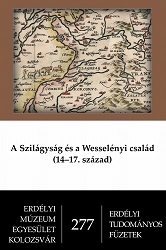A Szilágyság birtokviszonyai a középkorban
The Estate System of Sălaj (Szilágy) Region in the Late Middle Ages
Author(s): Géza Hegyi
Subject(s): Local History / Microhistory
Published by: Erdélyi Múzeum-Egyesület
Summary/Abstract: The paper examines the estate system of two counties of late medieval Hungary, Middle Szolnok and Crasna (Kraszna), in the 13th–16th century. More precisely, it discusses which settlement belonged to which family, what the power relations were between the landowners, how all this changed in time, and what reasons influenced these changes in property relations.Chapter I discusses the genesis of the local society of landowners in the Arpadian age. Prior to the beginning of the 13th century a significant part of the territory was royal land around castles or manors (várföld, udvarnokföld, erdőispánság). The large number of petty nobility (about 40 families) which gathered around Tășnad (Tasnád) and the hilly region between the rivers Zalău (Zilah) and Sălaj (Szilágy) were probably partly the descendants of the earliest Hungarian settlers and partly the descendants of castle servants rising in the 13th century. The oldest families of the highest-ranking kindreds were the Csolts in Crasna county and the Ákos and Káta families in Szolnok county (11th and 12th century), but other smaller kindreds (Farkasagmánd, Napkormeszte, Virteka, Turul) also settled in the region.The formation of church estates happened in the decades around 1200 – these, just like the villages of the petty nobility, were permanent, hardly changing elements of the estate system of Sălaj region in the Middle Ages.The middle nobility, owning 2–6 villages, came into being in the second half of the 13th century, when certain branches of the above mentioned kindreds (e.g. Széplaki, Csaholyi), the local royal servants (servientes) (e.g. Dédácsi, Szarvadi, Horváti, Sarmasági, Adi, etc.) or the nobles coming from distant counties in the service of barons had their shares of pieces of disintegrating royal estates. The largest part of these were acquired by the powerful nobles of the surrounding counties, of whom the Borsas, by the possession of the castle of Valcău (Valkó), gained supremacy over the two counties, while their allies, the Lothárdfis de genere Gútkeled, owned the territories of the later estates of Cheud (Aranyos) and Chioar (Kővár). The power of the Borsas and Lothárdfis was broken by King Charles I in 1317, as a result of which more than half of the two counties’ territories and three of the four castles of the region (Cheud, Chioar, Valcău) became royal estates (Chapter 2). This huge estate however started to be distributed already in 1341, and by 1410 there were no more royal lands in Sălaj region. Those who benefited from this process of distribution were all members of the royal court (barons and knights of the court). They gave rise to the large landowner elite of Sălaj region in the secondhalf of the 14th century, which remained unaltered to the mid-16th century: one branch of the Bátori family acquired the castle and villages of Șimleu (Somlyó) by marriage (1351), the Romanian-origin Bélteki family (ancestors of the Drágfi and Balkfi families) received the estates of Chioar (1378) and Ardud (Erdőd) (1385) as donation, the Jakcs family of Coșeiu (Kusaly) rising from the one-village nobility received the villages of the abbey of Meseș (Meszes) (1361), the estate of Hodod (Hadad) (1383) and Cheud (1387), while the Csáki family the estates of Craidorolț (Daróc) (1387) and Marghita (Margitta) (1422), and the estate of Valcău ended up in the possession of the Bánfi of Losonc family (1402). Beginning with the early 15th century, after the source of royal land donation had run dry, and no significant family had become extinct in the period between 1420 and 1542, the estate mobility decreased (1341–1446: 62,5%; 1446–1549: 40,7%), estates became more fragmented, and were exchanged, bought, gained by marriages and pawned. At the beginning of the 15th century, most successful in this was the Jakcs family, who even managed to acquire for a period the southern strip (approx. 20 villages) of the Drágfi’s estate in Țara Codrului (Bükkalja). In 1446, they owned 22% of the estates in Sălaj region. At this time, the two counties were under the hegemony of the Jakcs, Bánfi and Csáki families, who also bore baron’s offices. In chapter four, we can see how the Jakcs and Bánfi families were pushed in the background amidst the confusions of the 1440s–1450s, then the place of the former is taken by the Drágfis in the second part of the 15th century, and the place of the latter by the Bátoris of Șimleu (Somlyó) at the beginning of the 16th century.The Drágfis managed to regain their lost estates (1460–1462), then they laid hands on about half of the estate of Cheud in three stages (1472, 1494, 1524), while acquiring several estates in the neighbourhood of Tășnad (1474, 1477, 1483, 1486, 1492).Members of the family were always counts of the two counties beginning with 1476. One branch of the Bátoris gained around 40% of the estate of Valcău between 1508−1523 by way of marriage, and then by exchanges and pawning. At the turn of the 15th–16th century, we can also witness the rise of some families of the petty nobility (Dobai, Kőrösi, Désházi) who gained their lands mostly in the service of the Drágfis.The study ends with the short analysis of tax inventories from 1549, which offer the most comprehensive image of the society of the region. The author examines not only the proportion of various types of estates (those of the church, the aristocracy or common nobility) and the internal stratification of the nobility, but – on the model of the researches of Pál Engel – he also treats questions such as the problem of the survival of the elite of the Arpadian age.
Book: A Szilágyság és a Wesselényi család (14–17. század)
- Page Range: 45-134
- Page Count: 90
- Publication Year: 2012
- Language: Hungarian
- Content File-PDF

